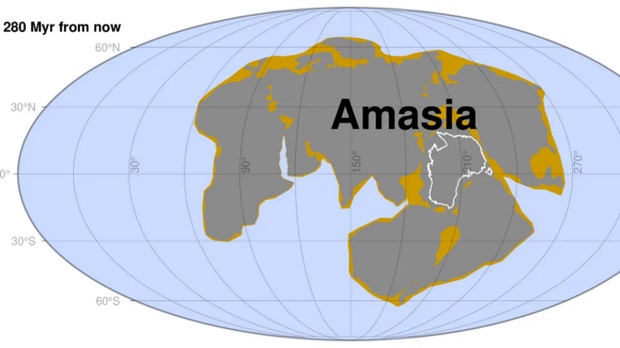
Amasia: in 200-300 million years, new supercontinent will appear on Earth, Pacific Ocean will disappear
In 200-300 million years, a new supercontinent will appear on Earth called Amasia, and the Pacific Ocean will disappear, said researchers from the University of New Curtin in Australia, who used a supercomputer to figure out how our planet will look like in the distant future.
Our planet is in constant motion, and it is not only about its rotation around the Sun, but also that its surface is moving and changing, just that these changes become noticeable only over millions of years.
According to the calculations that experts published in the National Science Review, in 200-300 million years on Earth will form a new supercontinent Amasia, which will result from the merger of the modern American and Asian continents.

The formation of continents
The cycle of supercontinents is considered a major feature of Earth's tectonic evolution. It began about 2 billion years ago, and since then, at intervals of about 600 million years, the entire landmass joins together to form a supercontinent, after which it separates into separate continents.
More than 700 million years ago, the previous supercontinent began to break apart and squeeze the Panthalassa super-ocean.
When dinosaurs still lived on Earth, this ocean was huge, but since then it has been steadily shrinking and shrinking.
Today we know it as the Pacific Ocean, and in the distant future it will most likely not exist at all: within the next 200-300 million years, the Pacific Ocean will shrink from its current size of thousands of miles, and in its place, the continents of America and Asia will merge to form Amasia.
Younger oceans, such as the Atlantic and Indian, are unlikely to disappear in the next cycle of tectonic plate movements, according to researchers' calculations.
Interestingly, the Australian continent will also play a role: even before Amasia is formed, it is expected to first collide with Asia and merge with it.
What will Amasia be like?
The geographical position of the seven continents today has a great impact not only on the environment and ecosystems on these continents but even on the culture and everyday life of the people who live on them.
What will life be like on the supercontinent? By the time the Amasia supercontinent is formed on Earth, life on the planet will be radically different from what it is today.
Scientists predict that water levels in the seas will drop, and the bowels of the supercontinent will become arid areas.
In addition, daytime temperatures are likely to be very high.
Who exactly will inhabit the planet by then and how comfortable they will be in these conditions is unlikely to be a guess.
- Related News
- "AMADEE-24" Mars Analog Research Mission in Armash came to an end
- NASA creates new generation solar sail: What is it for?
- Flying object resembling surfboard was detected in Moon’s orbit: What is it in fact?
- Total solar eclipse on April 8, 2024: The most impressive photos
- Total eclipse of Sun will take place today: From which parts of the country will it be seen?
- Amateur astronomer from Crimea discoves potentially dangerous asteroid for Earth
- Most read
month
week
day
- iPhone users are advised to disable iMessage: What risks are hidden in it? 1447
- Problems with Android 15: NFC contactless payments no longer work on smartphones with updated operating systems 1143
- Pavel Durov gives interview to Tucker Carlson: From 3-hour interview, less than hour appears in final version 1040
- AMD Ryzen 7 processor, 24 GB of RAM and only $550: Mechrevo presents inexpensive and powerful laptop (photo) 795
- The 5 most controversial buildings ever built: Bold design or complete failure? (photo) 770
- Black Shark smart ring from Xiaomi to have interesting characteristics and phenomenal autonomy: 180 days of operation without recharging (photo) 760
- Armenia takes 89th place in terms of mobile Internet speed, but leads region in terms of fixed line speed 660
- 3 best smartphones under $160 637
- Telegram receives major update and sticker editor 631
- No internet access required? How AI will work in iPhone 542
- Archive
